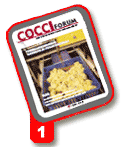COCCI News
Product updates and industry trends

Dr. Hiram Lasher (third from right) with Schering-Plough's Marcelo Lang, Larry Manogue, David Kelly, Stephen Collins, Anthony Macci and Fred Searl.
|
More than 150 producers, consultants, university specialists and other area officials affiliated with the Delmarva poultry industry gathered in Millsboro, Del., recently to toast the 50th anniversary of Schering-Plough Animal Health's
biologicals plant.
The company also took the occasion to honor Dr. Hiram Lasher, a local industry pioneer who started the plant in 1950 for his vaccine company company, Delaware Poultry Laboratories.
"We're proud of the plant's many contributions to the poultry industry over the last half century, and we're very enthusiastic about the role it will play in the worldwide poultry industry in the 21st century," said
Stephen Collins, vice president, worldwide poultry.
Schering-Plough Animal Health recently completed a $4 million expansion and modernization of the facility to meet increasing demand for the company's poultry vaccines.
Expansion of the Millsboro facility has allowed Schering- Plough Animal Health to consolidate vaccine production for greater efficiency. Poultry vaccines previously manufactured in the company's Nebraska plant will now be produced in
Millsboro.
"Millsboro has become our center of expertise for producing these specialty products," Collins said.
"Next on the drawing board is a new facility in Millsboro for manufacturing our Coccivac line of coccidiosis vaccines, which has seen tremendous growth over the past year."
Paracox-5 Approved in EU, Israel
Schering-Plough Animal Health has obtained marketing authorization from all 15 EU member countries and Israel to begin marketing Paracox™-5, a new attenuated vaccine that protects against the most economically significant species of
Eimeria causing coccidiosis in broiler chickens.
Paracox-5 allows producers to protect broilers from coccidiosis, without using drugs or sacrificing performance.
Vaccination for coccidiosis and other major poultry diseases is expected to become more prevalent as poultry producers respond to growing consumer demand for meat products produced without in-feed medications.
Paracox-5 is a translucent, aqueous suspension for oral administration.
The vaccine, which is sprayed on feed given to day-old chicks to stimulate natural immunity, contains live, attenuated sporulated oocysts derived from Eimeria acervulina, E. maxima CP, E. maxima MFP, E. mitis HP and E. tenella HP.
Immunity begins to develop within 14 days of vaccination and is complete by 28 days after vaccination. Paracox-5 remains active for at least 42 days post vaccination and, in practice, may last longer if birds are allowed to access new oocysts
present in the litter.
To help meet expected demand for the product, Schering- Plough Animal Health has invested US$9.8 million to increase the production capacity of its two plants in the U.K.
All Fun and Spray
Poultry veterinarians from Brazil tossed their first snowballs after touring Schering- Plough's expanded vaccine plant in Delaware. Later in the week, after a surprise blizzard in North Carolina, they braved more than 2 feet of snow to visit a hatchery of a major integrator spray vaccinating with Coccivac-B.
FDA Clears Three Clinacox Combinations
Schering-Plough Animal Health has received combination clearances from FDA allowing U.S. broiler producers to feed Clinacox (diclazuril) with BMD (bacitracin methylene disalicylate), Flavomycin (bambermycins) or Stafac (virginiamycin), three leading growth enhancers.
Clinacox is a potent synthetic anticoccidial for broiler chicks that has been used safely and effectively in Europe and other major poultry markets.
Because Clinacox is from a chemical family not previously used in the United States for coccidiosis, it is expected to be highly effective against ionophoreresistant Eimeria strains.
The product's active ingredient, diclazuril, has also received high marks for safety. Birds treated with Clinacox have shown no signs of toxicity or other potentially harmful side effects.
Tolerance trials have also demonstrated that diclazuril has a wide margin of safety for other farm animals, so there is no risk if feed containing Clinacox is misfed to turkeys, breeders hens, swine or cattle.
To preserve the high efficacy of this versatile and safe anticoccidial, Schering-Plough Animal Health strongly recommends using Clinacox for no more than two consecutive grow-outs and then rotating to a coccidiosis vaccine such as Coccivac-B or another anticoccidial feed additive.
Spray Cabinet Approved for Coccivac-D

|
Coccivac®-D, a live oocyst coccidiosis vaccine used for many years in breeders and layers, has been approved by USDA for spray cabinet administration.
The spray cabinet "already used successfully in broiler operations to administer another coccidiosis vaccine, Coccivac-B "distributes the vaccine more uniformly than other methods.
In broiler breeder and layer pullets reared on the ground, coccidiosis outbreaks can result in increased mortality, reduced weight gain and, subsequently, loss of flock uniformity.
Flocks affected by coccidiosis early in life may recover, but if an outbreak occurs late in the raising period (between 8 and 16 weeks of age), the flock may lose uniformity, which may have an impact on egg production, fertility and
hatchability.
With Coccivac-D, breeder flocks and layer pullets reared on floor are completely protected from all eight pathogenic species of coccidia that can affect the chickens.
The safety of Coccivac-D administered by spray cabinet on the day of hatching was demonstrated in recent field studies conducted at poultry farms in Tennessee, Kentucky and Georgia.
No increases in mortality were reported, nor did producers involved with the trials observe side effects in vaccinated breeders and layers.
Source: CocciForum Issue No.1, Schering-Plough Animal Health.







